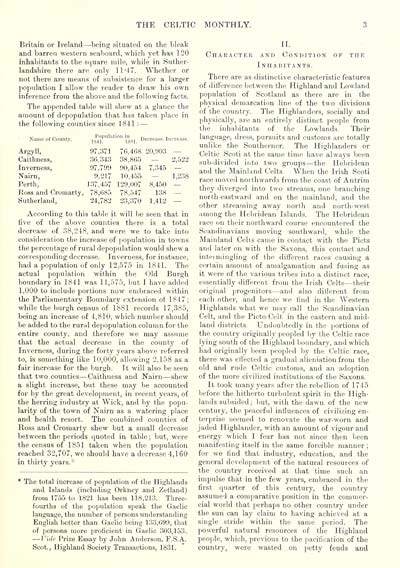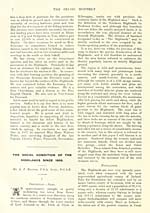Blair Collection > Celtic monthly > Volume 7, 1899
(15)
Download files
Complete book:
Individual page:
Thumbnail gallery: Grid view | List view

THE CELTIC MONTHLY.
Britain or Ireland — being situated on the bleak
and barren western seaboard, wliich yet has 120
inhabitants to the square mile, while in Suther-
landshire there are only 1 1 '47. Whether or
not there are means of subsistence for a larger
population I allow the reader to draw his own
inference from the above and the following facts.
The ap|)ended table will shew at a glance the
amount of depopulation that has taken place in
the following counties since 1841 : —
Ross and Cromarty, 78,085 78,547 138 —
Sutherland, 24,782 23,370 1,412 —
According to this taVjle it will be seen that in
five of the above counties there is a total
decrease of 38,248, and were we to take into
consideration the increase of ]iopulation in towns
the percentage of rural depopulation would shew a
corresponding decrease. Inverness, for instance,
had a population of only 12,575 in 1841. The
actual population within the Old Burgh
boundary in 1841 was 11,575, but I have added
1,000 to include portions now embraced within
the Parliamentary Boundary extension of 1847;
while the burgh census of 1881 records 17,385,
being an increase of 4,810, which number should
be added to the rural depopulation column for the
entire county, and therefore we may assume
that the actual decrease in the county of
Inverness, during the forty years above referred
to, is something like 10,000, allowing 2,158 as a
fair increase for the burgh. It will also be seen
that two counties — Caithness and Nairn — shew
a slight increase, but these may be accounted
for by the great development, in recent years, of
the herring industry at Wick, and by the popu-
larity of the town of Nairn as a watering place
and health resort. The combined counties of
Ross and Cromarty shew but a small decrease
between the periods quoted in table; but, were
the census of 1851 taken when the population
reached 32,707, we should have a decrease 4,160
in thirty years.*
* The total increase of population of the Highlands
and Islands (including Orkney and Zetland)
from 1755 to 1821 has been 118,213. Three-
fourths of the population speak the Gaelic
language, the number of persons understanding
English better than Gaelic being 133,099, that
of persons more proficient in Gaelic 303,153.
— T'iiii' Prize Essay by John Anderson, F.S.A.
Scot., Highland Society Transactions, 1831.
IL
Character and Condition of the
iNIIAniTANTS.
There are as distinctive characteristic features
of ditlerejice between the Highland and Lowland
population of Scotland as there are in the
j)hysical demarcation line of the two divisions
of the country. The Highlanders, socially and
jihysically, are an entirely distinct people from
the inhaliitants of the Lowlands Their
language, dress, pursuits and customs are totally
unlike the Southerner. The Highlanders or
Celtic Scoti at the same time have always been
sub-divided into two groups — the Hebridean
and the Mainland Celts When the Irish Scoti
race moved northwards from the coast of Antrim
they diverged into two streams, one branching
north-eastward and on the mainland, and the
other streaming away north and north-west
among the Hebridean Islands. The Hebridean
race on their northward course encountered the
Scandinavians moving southward, while the
Mainland Celts came in contact with the Picts
and later on with the Saxons, this contact and
intei mingling of the different races causing a
certain amount of amalgamation and fusing as
it were of the vaiious tribes into a distinct race,
essentially different from the Irish Celts — their
original progenitors — and also different from
each other, and hence we find in the Western
Highlands what we may call the Scandinavian
Celt, and the Picto-Celt in the eastern and mid-
land districts. Undoubtedly in the portions of
the country originally peopled by the Celtic race
lying .south of the Highland boundary, and which
had originally been peopled by the Celtic race,
there was effected a gradual alieniation from the
old and rude Celtic customs, and an adoption
of the more civilized institutions of the Saxons.
It took many years after the rebellion of 1745
before the hitherto turbulent spirit in the High-
lands subsided ; but, with the dawn of the new
century, the peaceful influences of civilizing en-
terprise seemed to renovate the war-worn and
jaded Highlander, with an amount of vigour and
energy which I fear has not since then been
manifesting itself in the same forcible manner;
for we find that industry, education, and the
general development of the natural resources of
the country received at that time such an
impulse that in the few years, embraced in the
first quarter of this century, the country
assumed a comparative position in the commer-
cial world that perhaps no other country under
the sun can lay claim to having achieved at a
single stride within the same period. The
powerful natural resources of the Highland
people, which, previous to the pacification of the
country, were wasted on petty feuds and
Britain or Ireland — being situated on the bleak
and barren western seaboard, wliich yet has 120
inhabitants to the square mile, while in Suther-
landshire there are only 1 1 '47. Whether or
not there are means of subsistence for a larger
population I allow the reader to draw his own
inference from the above and the following facts.
The ap|)ended table will shew at a glance the
amount of depopulation that has taken place in
the following counties since 1841 : —
Ross and Cromarty, 78,085 78,547 138 —
Sutherland, 24,782 23,370 1,412 —
According to this taVjle it will be seen that in
five of the above counties there is a total
decrease of 38,248, and were we to take into
consideration the increase of ]iopulation in towns
the percentage of rural depopulation would shew a
corresponding decrease. Inverness, for instance,
had a population of only 12,575 in 1841. The
actual population within the Old Burgh
boundary in 1841 was 11,575, but I have added
1,000 to include portions now embraced within
the Parliamentary Boundary extension of 1847;
while the burgh census of 1881 records 17,385,
being an increase of 4,810, which number should
be added to the rural depopulation column for the
entire county, and therefore we may assume
that the actual decrease in the county of
Inverness, during the forty years above referred
to, is something like 10,000, allowing 2,158 as a
fair increase for the burgh. It will also be seen
that two counties — Caithness and Nairn — shew
a slight increase, but these may be accounted
for by the great development, in recent years, of
the herring industry at Wick, and by the popu-
larity of the town of Nairn as a watering place
and health resort. The combined counties of
Ross and Cromarty shew but a small decrease
between the periods quoted in table; but, were
the census of 1851 taken when the population
reached 32,707, we should have a decrease 4,160
in thirty years.*
* The total increase of population of the Highlands
and Islands (including Orkney and Zetland)
from 1755 to 1821 has been 118,213. Three-
fourths of the population speak the Gaelic
language, the number of persons understanding
English better than Gaelic being 133,099, that
of persons more proficient in Gaelic 303,153.
— T'iiii' Prize Essay by John Anderson, F.S.A.
Scot., Highland Society Transactions, 1831.
IL
Character and Condition of the
iNIIAniTANTS.
There are as distinctive characteristic features
of ditlerejice between the Highland and Lowland
population of Scotland as there are in the
j)hysical demarcation line of the two divisions
of the country. The Highlanders, socially and
jihysically, are an entirely distinct people from
the inhaliitants of the Lowlands Their
language, dress, pursuits and customs are totally
unlike the Southerner. The Highlanders or
Celtic Scoti at the same time have always been
sub-divided into two groups — the Hebridean
and the Mainland Celts When the Irish Scoti
race moved northwards from the coast of Antrim
they diverged into two streams, one branching
north-eastward and on the mainland, and the
other streaming away north and north-west
among the Hebridean Islands. The Hebridean
race on their northward course encountered the
Scandinavians moving southward, while the
Mainland Celts came in contact with the Picts
and later on with the Saxons, this contact and
intei mingling of the different races causing a
certain amount of amalgamation and fusing as
it were of the vaiious tribes into a distinct race,
essentially different from the Irish Celts — their
original progenitors — and also different from
each other, and hence we find in the Western
Highlands what we may call the Scandinavian
Celt, and the Picto-Celt in the eastern and mid-
land districts. Undoubtedly in the portions of
the country originally peopled by the Celtic race
lying .south of the Highland boundary, and which
had originally been peopled by the Celtic race,
there was effected a gradual alieniation from the
old and rude Celtic customs, and an adoption
of the more civilized institutions of the Saxons.
It took many years after the rebellion of 1745
before the hitherto turbulent spirit in the High-
lands subsided ; but, with the dawn of the new
century, the peaceful influences of civilizing en-
terprise seemed to renovate the war-worn and
jaded Highlander, with an amount of vigour and
energy which I fear has not since then been
manifesting itself in the same forcible manner;
for we find that industry, education, and the
general development of the natural resources of
the country received at that time such an
impulse that in the few years, embraced in the
first quarter of this century, the country
assumed a comparative position in the commer-
cial world that perhaps no other country under
the sun can lay claim to having achieved at a
single stride within the same period. The
powerful natural resources of the Highland
people, which, previous to the pacification of the
country, were wasted on petty feuds and
Set display mode to: Large image | Transcription
Images and transcriptions on this page, including medium image downloads, may be used under the Creative Commons Attribution 4.0 International Licence unless otherwise stated. ![]()
| Early Gaelic Book Collections > Blair Collection > Celtic monthly > Volume 7, 1899 > (15) |
|---|
| Permanent URL | https://digital.nls.uk/75858759 |
|---|
| Shelfmark | Blair.59 |
|---|---|
| Additional NLS resources: | |
| Attribution and copyright: |
|
| Description | A selection of books from a collection of more than 500 titles, mostly on religious and literary topics. Also includes some material dealing with other Celtic languages and societies. Collection created towards the end of the 19th century by Lady Evelyn Stewart Murray. |
|---|
| Description | Selected items from five 'Special and Named Printed Collections'. Includes books in Gaelic and other Celtic languages, works about the Gaels, their languages, literature, culture and history. |
|---|

